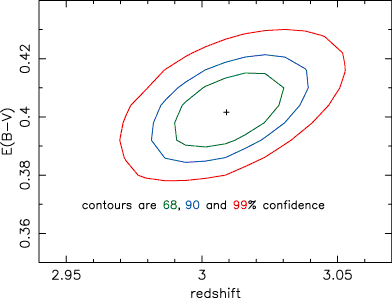Swift Redshift Measurements
Measurements of the gamma-ray spectra obtained during the prompt emission of the GRB have found little value as redshift indicators, due to the lack of well-defined spectral features. However, optical observations of GRB afterglows have produced spectra with identifiable lines, leading to precise redshift measurements (e.g., z = 0.835, 3.418, and 0.966 for GRBs 970508, 971214, and 980703).
The UVOT has a grism which can produce spectra of objects brighter than 15th magnitude. However, most GRB afterglows will rapidly fade below this limit. For most GRBs, Swift attempts to measure redshifts by using the UVOT to find the Lyman edge (see below). Swift redshift estimates have a precision of approximately 0.1, compared to ground-based measurements with accuracies of approximately 0.001. At cosmological distances, the Swift redshift estimates are more accurate than the currently known conversion between redshift and distance, so the reduced precision has little scientific impact. The ability to use the UVOT grism to determine the redshift of a GRB depends on the brightness of its afterglow, the absorbing material in front of the GRB, and the redshift of the GRB.
The amount of absorbing material is often parameterized by the column density, NH, which is the number of hydrogen atoms in a 1 cm square column between the observer and the source. Since hydrogen is not always the material which absorbs the photons, this is adjusted using estimates for the number of heavier atoms and dust particles per hydrogen atom, which depends on the properties of the interstellar medium. UVOT spectra can indicate if the region around a GRB is full of the cast-off debris of older stars or the coalescing gas forming new stars, or even if the object that produced the GRB had a history of blowing dusty winds into the space around itself.
The Lyman edge technique for determining the redshift requires that the line-of-sight to be relatively dust-free, so that the visible and ultraviolet light is not clouded out. Ground-based optical measurements of faint sources require that strong spectral features be visible in the wavelength range observable through the atmosphere, and so have trouble with the redshift range 1.3 < z < 2.5.
For 1 < z < 5, the Lyman edge (the wavelength beyond which hydrogen atoms block all ultraviolet light) is redshifted into the wavelength band of the UVOT. With the six color filters of the UVOT, the location of the edge can be measured, as the GRB afterglow will be visible with the redder filters but undetectable in the bluer filters. The redshift can be measured with an accuracy of roughly 0.1. Steidel et al. (1996) have used this technique with two colors and find it robust.

This is the result of a simulation of this technique, as applied to six-color (1000 s per exposure) observations of a 20th magnitude GRB afterglow at z = 3, and with an extinction due to dust of EB-V = 0.4. Dust preferentially blocks bluer light, and can obscure the Lyman edge in dim afterglows.
The brightness of the burst and afterglow, and its approximate redshift (if the afterglow is bright enough), are available shortly after the BAT triggers on a GRB, allowing ground-based observers enough information to determine whether the GRB is worthy of follow-up studies using over-subscribed and expensive ground-based instruments. Bursts that are special in various ways, such as being extremely luminous, very distant, or excessively obscured, may be studied using various techniques and instruments to study the central engine of the GRB, its afterglow, and the nature of its environment.


